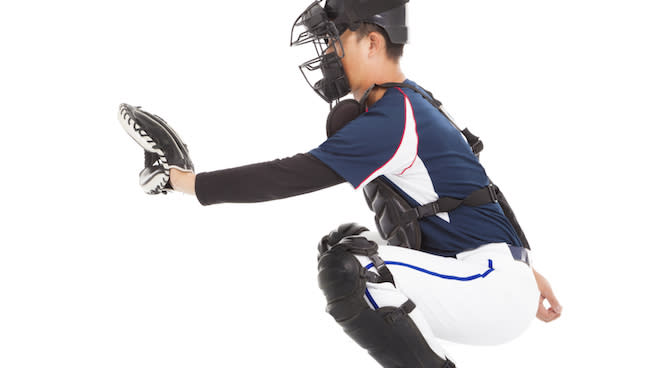Baseball Catcher Technique, Part 4

One of the most exciting plays in baseball is a runner trying to score as a throw is on its way to the catcher. Here's an overview of the skills involved in plays at the plate, as well as some sample drills.
Play at the Plate Drills
Catching the ball and making the tag. This requires proper foot placement, body turn, reading the throw, feeling where the runner is, and making the catch. Catchers: for protection, make sure to keep your mask on for the entire play on the field.
RELATED: Block More Pitches With These Catcher Drills
Making a play at the plate. Here, the catcher first tells the pitcher to back up home plate, then lines up his relay man. On balls hit to right field or center field, the first baseman is the relay man. On balls hit to left field, the third baseman is the relay man. The pitcher sprints behind the catcher to back up the throw.
The catcher must line up the relay man with the ball and the plate with verbal commands—right or left. The catcher places his left foot on the left front corner of the plate as he directs traffic, keeping his mask on. His right shoulder should be pointed at the relay man to give him a good target with the glove as the relay man turns to throw the ball home. Communication with the relay man is crucial.
As the ball approaches, the catcher must make sure he is ready for contact from the baserunner. The runner will most likely slide into the catcher. The catcher should be in a slight squat to decrease the chance of a knee injury. The catch and tag are done with two hands. The ball goes from sitting inside the glove to being squeezed by the catcher's bare hand hidden inside the mitt. Transferring the ball to the hand reduces the chance of the ball becoming dislodged as the runner slides in.
As the catcher transfers the baseball to his throwing hand, his right knee comes down in a sliding motion toward the backstop to use his shin guards to "block" the plate. This protects the catcher's legs from the runner's spikes. As his knee comes down, the catcher tags with the mitt (remember the ball is in his bare hand hidden inside the mitt.) After the catcher tags the runner out, the slide motion towards the backstop lets him come up in an ideal position to throw out the secondary runner.
WATCH: Joe Mauer's On-Field Skill Development
Split decision. Certain situations force the catcher to move from the plate and catch the ball to throw out the runner attempting to take second base. This play requires a split decision that the catcher must work on to be prepared for game situations. It ensures the opposition does not score a run and get another runner in scoring position.
Foul pop-up. When a batter hits a foul pop-up close to the plate, it can be a difficult play for the catcher, because the ball always spins back toward the infield. The catcher must turn opposite from the batter. Think about when a right-handed hitter hits a foul pop-up—it typically goes toward the first base dugout.
As the catcher turns and finds the ball, his mask should stay on. Years ago, with a two-piece helmet and mask, the catcher was taught to remove the mask and throw it. A one-piece mask should stay on if it is sized properly. On a high pop-up, the catcher should keep his feet moving until the ball is secured in his mitt with his bare hand on top of the ball. The continuous footwork allows the catcher to adjust as the ball comes down.
Youth Baseball Catcher Drills
Practice verbal communication with teammates.
Practice foot placement, shoulder turn and a slight bend in the knees for plays at the plate. The coach can hit or throw the ball to the catcher from a relay position for the catcher to work on good and bad throws.
Practice catching the ball and sliding across the plate, leading with your right knee. The coach should make minimal contact with the catcher to practice securing the baseball, then popping up in an ideal throwing position to throw out the secondary runner.
Practice setting up at the plate for a throw, then leaving the plate to catch the baseball and throw out the secondary runner.
Practice foul pop-ups. The coach stands behind the catcher, who is in his receiving stance. The coach tosses the ball up in the air and says, "now!" The catcher should turn to find and catch the ball. Coaches should throw the ball underhanded and let the spin rotate toward the field to replicate the spin on a real foul ball.
READ MORE:
This article originally appeared on STACK.com: Baseball Catcher Technique, Part 4

